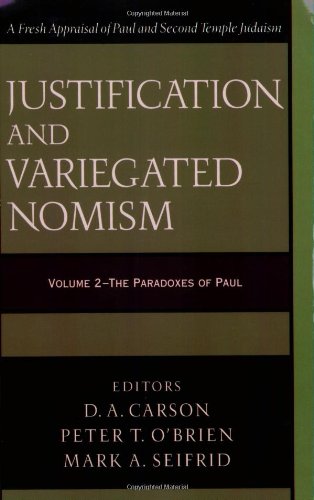A “Bonus” Chapter Summary from Books At a Glance
By Nathan Sundt
About the Author
Peter O’Brien is Senior Research Fellow in New Testament, Moore Theological College.
Overview
Peter O’Brien begins his chapter by rehearsing conceptually Sanders’s Covenantal Nomism (CN): to the Jew, “Israel’s covenant relation with God was basic to his sense of national identity and his understanding of religion.” God specially chose Israel, giving the law to express election and maintain relationship, this appropriate conduct being the referent for the term righteousness. Sanders insists “that obedience to the law in Judaism was not thought of as the means of entering the covenant or of establishing a relationship with God but the means of maintaining the covenant—not for “getting in” but for “staying in.”
Paul’s vigorous contention with the law, therefore, is not based in something so fundamental as a ‘pattern of religion’ but based on a matter of the history of redemption (Heilgeschichte). O’Brien cites and will later return to “two other major players “of great significance: James Dunn and N.T. Wright. Dunn’s work in the first-century “parting of the ways” and in removing “works of law” from the theological matrix of universal sin and salvation has gained traction among many scholars, as has Wright’s work on the “hope of Israel” and the ongoing exile.
These various elements in place, O’Brien proceeds to the central burden of the article: “How useful a category, then, is covenantal nomism for understanding Paul?” The argument proceeds in five steps: (1) to juxtapose Sanders’s concept and the conclusions of the research into Second-Temple Judaism; (2) to juxtapose those same key elements of the CN construct with the main contours of Paul’s thought; (3) to “evaluate the distinctive contributions of James Dunn and (4) and N.T. Wright to the ‘new perspective’, focusing particularly on those features that have to do with our subject of justification”; (5) to develop conclusions and test the persuasive power and heuristic fit of the CN model.
Section 1 explains how Sanders’s approach is manifestly less theological and more sociological, aiming to address how religion is perceived to function by its adherents. O’Brien responds to Sanders’s proposal with respect to the period of the Second Temple in six points: first, that the nomism pattern was present in some literature but was not found everywhere; second, that the model reduces the data to which it is responsible (large portions of the Hebrew canon playing no major role); third, the assumption of uniformity across the literature turns out to be misleading; fourth, the construction of certain deep categories may be mistaken (for example, the very meaning of election may not apply rightly in a volume like Jubilees); fifth, righteousness and covenant are severable in the OT, creation itself being the more foundational background for the meaning of righteousness; finally, even where the model fits, the poor nature of the fit belies the hackneyed nature of the model (O’Brien cites, for example, the Lives of Adam and Eve whose “elaborate penance that is necessary to return to God” does gainsay a truly grace-filled entrance into the covenant).
The chapter’s centerpiece is the second heading, “Does the Model Fit Paul?” The section proceeds in four queries, the first three of which investigate the three most essential features of the Sanders model and the fourth of which is a key question elicited by the preceding discussion: (1) Getting in the covenant, (2) Staying in the covenant, (3) Judgment according to works, (4) “Anthropological differences between Judaism and Paul.”
O’Brien notes the connection between the word-group and the theological concepts of election and the “getting in” social feature of Sanders’s schema: “Sanders’s support for his starting point of Israel as the chosen people of God seems entirely appropriate since the nation’s election is comprehensively presented in the Old Testament.” Sanders further. . .
[To continue reading this summary, please see below....]The remainder of this article is premium content. Become a member to continue reading.
Already have an account? Sign In
Buy the books

JUSTIFICATION AND VARIEGATED NOMISM (VOLUME 2): PARADOXES OF PAUL, edited by D. A. Carson, Peter T. O'Brien, and Mark A. Seifrid